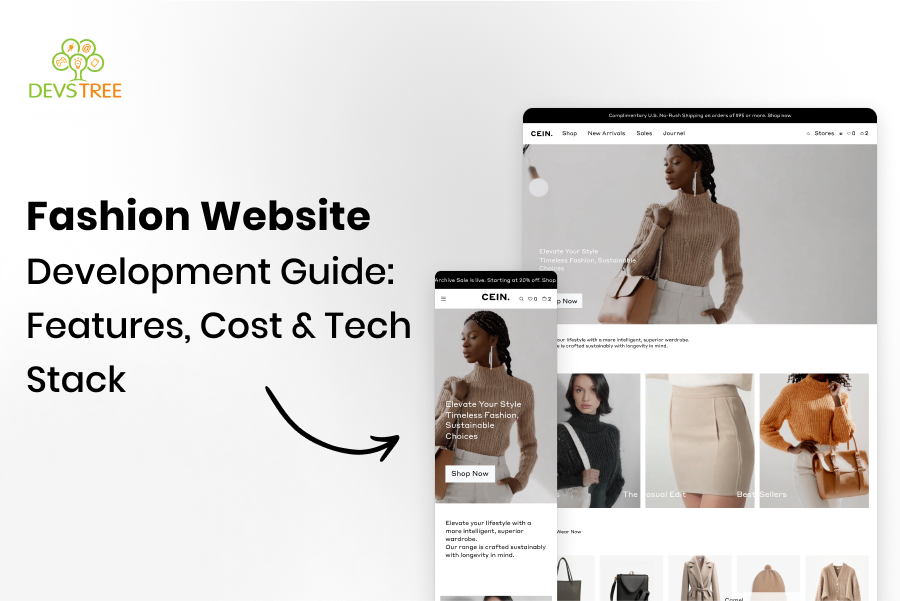
Building a fashion website is an exciting venture that blends creativity with technology. Whether you’re launching an online store, a fashion blog, or a portfolio, fashion eCommerce web development can set you apart in the competitive fashion industry. Partnering with a skilled web development company ensures your vision comes to life. This guide covers the essential features, estimated costs, and recommended tech stack for developing a fashion website.
Key Features of a Fashion Website
A successful fashion website should be visually appealing, user-friendly, and functional. Working with an eCommerce web development company can help implement these must-have features:
- Responsive Design: Ensures your site looks great on desktops, tablets, and smartphones.
- High-Quality Visuals: Large, high-resolution images and videos to showcase products or designs.
- E-commerce Functionality: For online stores, include product listings, shopping carts, and secure checkout.
- Search and Filters: Allow users to search by category, size, color, or price for a seamless shopping experience.
- User Accounts: Enable customers to save preferences, track orders, and manage wishlists.
- Blog Section: Share fashion tips, trends, or behind-the-scenes content to engage visitors.
- Social Media Integration: Connect your site to Instagram, Pinterest, or TikTok to boost engagement.
- SEO Optimization: Improve visibility on search engines with optimized content and metadata.
- Fast Load Times: Optimize images and code to ensure quick page loading.
Cost of Developing a Fashion Website
The cost of fashion eCommerce web development varies based on complexity, features, and whether you hire website developer teams or a full-service web development company. Here’s a breakdown:
- Basic Website (Blog or Portfolio): $1,000–$5,000. Includes a simple design, basic features, and a CMS like WordPress.
- Small E-commerce Site: $5,000–$20,000. Covers product listings, payment gateways, and moderate customization.
- Custom Fashion E-commerce Platform: $20,000–$100,000+. Includes advanced features like AI recommendations, custom UI/UX, and scalability.
Additional Costs:
- Domain and Hosting: $10–$500/year, depending on the provider and plan.
- Maintenance: $500–$5,000/year for updates, security, and backups.
- Marketing (SEO, Ads): $1,000–$10,000/year for campaigns to drive traffic.
Using pre-built platforms like Shopify or WooCommerce can reduce costs, while partnering with a web design agency for custom development offers more flexibility but increases expenses.
Recommended Tech Stack
Choosing the right tech stack ensures your website is scalable, secure, and efficient. An experienced e-commerce web development company can recommend the best tools for fashion e-commerce web development. Here’s a suggested stack:
- Frontend:
- React.js: For dynamic, interactive user interfaces.
- Tailwind CSS: For modern, customizable styling.
- Next.js: For server-side rendering and SEO optimization.
- Backend:
- Node.js + Express: For fast, scalable APIs.
- Python (Django/Flask): For rapid development and robust security.
- Database:
- MongoDB: For flexible, scalable product data storage.
- PostgreSQL: For structured data like user accounts and orders.
- E-commerce Platforms:
- Shopify: For quick setup and built-in e-commerce tools.
- WooCommerce: For WordPress-based stores with customization.
- Hosting/Deployment:
- AWS/Google Cloud: For scalable, reliable hosting.
- Vercel: For easy deployment of Next.js apps.
- Other Tools:
- Stripe/PayPal: For secure payment processing.
- Algolia: For advanced search and filtering.
- Cloudinary: For image optimization and management.
For smaller projects, a WordPress site with a premium theme and plugins can be a cost-effective alternative, especially if you hire website developer resources for customization.
Development Tips
Collaborating with a web development company can streamline the process. Here are some tips:
- Prioritize UX: Fashion websites thrive on intuitive navigation and stunning visuals.
- Optimize for Mobile: Over 50% of fashion shoppers use smartphones.
- Test Thoroughly: Check for bugs, broken links, and payment issues before launch.
- Plan for Scalability: Choose a tech stack that can handle traffic spikes during sales or campaigns.
Conclusion
Developing a fashion website through fashion eCommerce web development requires careful planning, from selecting the right features to choosing a scalable tech stack. Whether you work with a web design agency, an eCommerce web development company, or hire website developer talent, prioritize user experience and performance to stand out in the fashion industry. By understanding costs and technologies, you can create a website that not only looks great but also drives business success.

